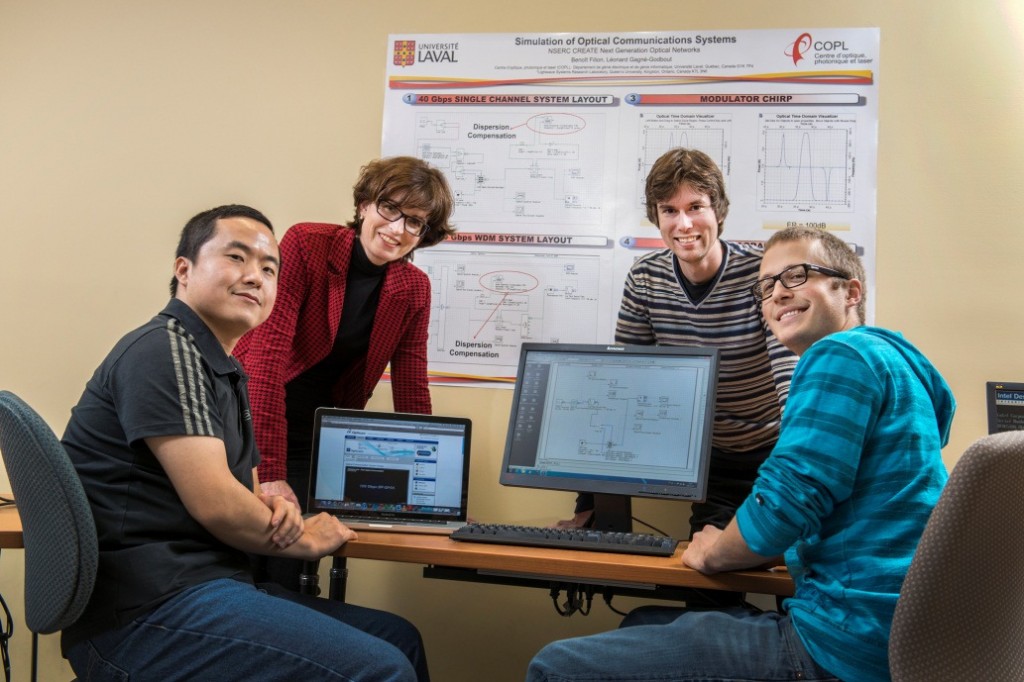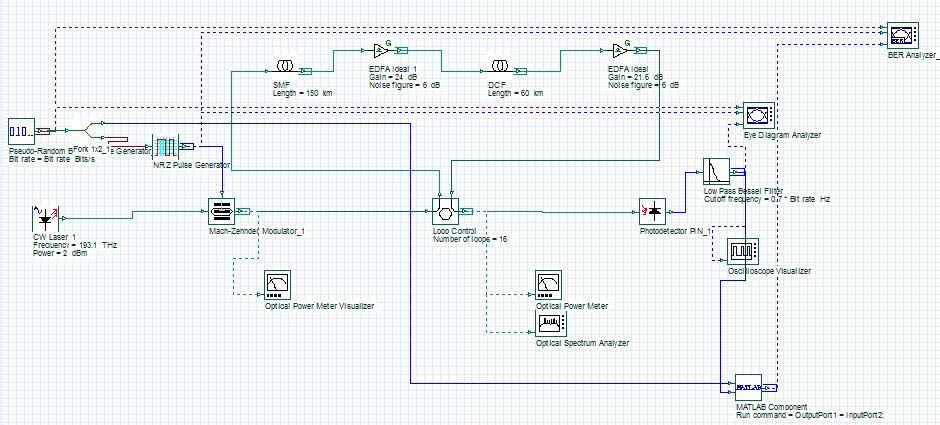Preparation of highly qualified personnel to drive the optical communications industry and spur innovation requires training adapted to that industry’s requirements. In Canada, the Next Generation Optical Networks (NGON) consortia was created at Queen’s University, Université Laval and McGill University to provide graduate students with targeted training with industrial input and participation. One outcome was the creation of a common graduate course on the simulation of optical communications systems, first offered during the winter semester 2012.

Figure 1: Prof. LaRochelle (U. Laval) and graduate students B. Filon, L. Gagné-Godbout and C. Jin (clockwise) discussing an simulation assignment on OptiSystem.
The thirteen week course was given on-line using Elluminate, an environment that allows the instructor to share desktop applications and demonstrate simulation tools. Students were able to participate by asking questions verbally or using a chat window, as well as having access to archived video of the three hour lectures. Practical training took the form of six assignments involving numerical simulations of devices or systems. Some aspects of the assignments required students to write their own code Matlab, while other aspects were based on the use of the OptiSystem simulation package generously provided to NGON by Optiwave Systems Inc. The detailed course content is presented below in Table 1. The course culminated with a system simulation project that involved the design and optimization of a 2400 km link. Students were able to identify factors that deterministically limit the system performance and to make compromises in order to achieve the optimum performance. Students presented their solution to their colleagues during the last session. This course was evaluated as a regular graduate course and students received credit for a one-term course towards their degree requirements.
| Week | Topics |
| 1 | Optical communication system overview and introduction to system simulation and digital representation of signal and noise for system simulations. |
| 2 | Mathematical modeling of noise (simulation of random Poisson and Weiner processes, electrical and optical noise) in the context of amplified WDM transmissions. |
| 3-4 | Description of semiconductor lasers using deterministic and stochastic rate equations and their implementations for system simulations and laser performance assessment. |
| 5-6 | Mathematical models of optical modulators for amplitude and/or phase modulation formats and their implementations for system simulations. |
| 7-8 | Linear and nonlinear propagation equations in optical fibers in their numerical solution for system simulations taking into account dispersion and third order nonlinearities. |
| 9 | Properties of optical filters (integrated waveguide filters, arrayed-waveguide-gratings, fiber gratings) and calculation of their transfer function for system simulations. |
| 10 | Operating principle of EDF and numerical tools for amplifier response simulations in optical communication links including optical noise and dynamic response calculations. |
| 11 | Calculation of system performance at the receiver for various modulation formats (BER, Q-factor, OSNR sensitivity) with respect to system parameters (dispersion, nonlinearity). |
| 12 | Forward error correction (encoding/ decoding/ implementations) and impact of coding on system performance. |
| 13 | Project presentation on the design of an optical communication link. |
Table 1 : On-line graduate course content
Instructors found the OptiSystem software to be an efficient teaching tool that helped to understand the various trade-offs involved when designing an optical
communication link. Its comprehensive design suite helped students bridge the gap between the understanding of the physical models and their mathematical
representations, and the impact of the different parameters on system performance. The software enabled students to experiment with optical link and network design in
a flexible manner. Indeed, OptiSystem allows integration of Matlab code to support co-simulation in a fast and easy manner. Figure 2 below shows such an optical
communication link project. Graduate student Lin Dong considers the ability of OptiSystem to connect to Matlab a very helpful feature and she said: “The interesting
thing about OptiSystem is that if you need to create a function that is not provided in the simulator, it is easy to implement it in Matlab and then import it to OptiSystem”.
Students found the optical spectrum analyzer and time domain visualizers tools very helpful to help them build their simulation. Furthermore, OptiSystem provides a hierarchically organized library of components and has a generous supply of examples that helped the students get started. Xiaoyu Gong, a student who was taught about using the simulator during this course describes his experience: “OptiSystem is very useful in learning about optical communications. All kinds of optical links can be easily built and tested. The detailed and well organized tutorials are really impressive. The Matlab library makes the simulator an even more flexible and powerful tool”.

Figure 2: Simulation of an optical communication link using Optisystem
This graduate course contributed to developing student expertise by hands-on training in numerical simulations, interpersonal skills through networking with
colleagues from other institutions, and leadership and planning in executing the projects. The exposure to Matlab provided an in-depth, often component level,
simulation environment where models could be tweaked to observe the effect on output predictions. The OptiSystem environment offers a comprehensive platform for
elaborate simulation setups, with the possibility of incorporating component-level simulations from Matlab. Exposure to the ecosystem of numerical simulation tools
provided these students with skills that could be immediately applied on their integration into industrial research and development for demanding, state-of-the-art
optical networks.

